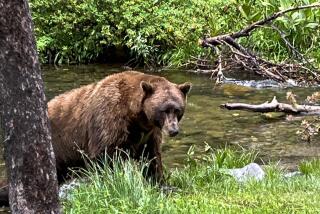Inspected by ...
- Share via
The grizzly’s nose twitches.
Something in that trash can smells delicious.
“Sam. It’s an enjoyment for him to break things open,” says Randy Gravatt, a naturalist at the Grizzly & Wolf Discovery Center in West Yellowstone, Mont., while watching a product-testing session the other day. “He’s been called Houdini more than once.”
Is the 95-gallon metal container, an invention of Colorado prison inmates, worthy of a coveted bear-resistant label from the Living with Wildlife Foundation?
At 920 pounds, Sam will be the judge of that. He power-licks its peanut butter-lathered hinges, his pink tongue working creamy Peter Pan from the grooves. With a gentle slap of the paw, the container gongs to its side and Sam slurps up mackerel juice seeping from the seams.
Righting the can again, he strokes the lid, claws clacking as he searches for an opening.
Meanwhile, his kid sister Illie, just 720 pounds, bounces on a nearby decoy cooler that caretakers planted to distract her, lest Sam get all the fun. One. Two. Three. The lid springs, and she scarfs up the kibble within. (The siblings arrived at the center near the western gateway to Yellowstone National Park in 1996 after rangers busted the orphaned cubs for raiding campgrounds in Alaska’s Katmai National Park.)
Sam dribbles the stubborn trash can with his front paws like a soccer ball, then abandons it and sniffs out another bearproof product. He lumbers, fat rippling under golden fur, over to a plastic backpacker bear canister and daintily rolls the cylinder, designed as a food-storage container, over to a concrete-lined pond. Into the water it plops. Sam fishes it out and kneads it against the concrete. Pop. Victorious, the grizzly noses past the cap and sucks out his prize: “Hearty cuts and gravy” dog food with apricot-pineapple jelly.
-- Rebecca Huntington






